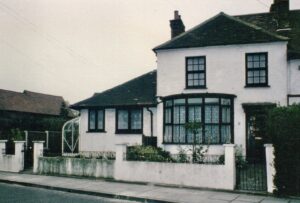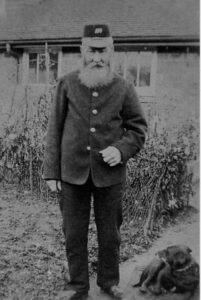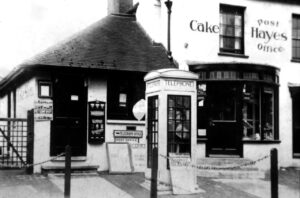Glebe View
8/8a Baston Road
Early 19th century with extension 1894
Post Office 1894 – 1940
Locally listed
No 8 Baston Road was originally a two storey detached house which was owned by Thomas Staple, a tailor and shopkeeper, and seems to exist by 1814. The house was let until 1830 when Ann Staples was recorded living there. On her death in 1840 ownership passed to her son Thomas who leased the property to William Alp, a retired victualler, until the 1860s.
Arrival of Robert Pearce (tenant 1880 – 1940)
By 1880 Robert Pearce had moved into the house with his wife Phoebe and two young children. Robert was born in one of the three cottages facing the Cricket Ground (later Ivy Cottage), where he helped his father Thomas who was a florist
Death of Thomas Staple
The owner, Thomas Staple, died in 1885 and his properties were bought by Sir Everard Hambro of Hayes Place. A major rebuilding and refurbishment took place which is shown by comparing the detached house shown on the Tithe Map, No. 204, and the position in 1898 where it is called the Post Office. The house had now become semi-detached with the addition of Elleray, 6 Baston Road to the north. Robert Pearce continued to live at No 8, known as Glebe View, and had five children by 1891.
South Extension
Three years later a single storey extension in brick with a slate roof was added to the south of the property. It became used as the Hayes Post Office and was completed by 11 March 1894 when Robert Pearce took over the postal services. The sorting office was in the rear of the extension.
In 1910 it was recorded that he was paying 4/3d (21p) a week in rent and that his house was worth £300. It was described as brick built and slated, bricks built on edge, in good decorative and structural condition. It had a sitting room, kitchen scullery, larder, 2 bedrooms, a box room and an earth closet.
Post Office
In the 1911 Census Robert Pearce was described as a sub postmaster and he was helped by his two daughters Amy & Bessie. They sorted the incoming mail into the various rounds and post marked the outgoing mail. There was an old fashioned telephone on the wall, the mouthpiece being fixed, and the ear trumpet detachable which clipped to the wall when not in use. This was not only used for sending and receiving telegrams but gentlemen who were being kept late at business would ring to ask them to send a message home to their wives, to let them know. All part of the service in those days. Christiana Timms recalled that the telegraph boy was the only one who had a bicycle in those days and she remembered her father Charles Harrod, a postman, saying that he had to walk as far as Leaves Green, sometimes delivering letters to a farmer which could mean a trip across ploughed fields. The mail which arrived at Hayes Station from Beckenham was picked up by her grandfather in the early morning in the handcart which he used as a gardener on Hayes Place Estate. In the evening he took back the outward mail.
Robert Pearce would deliver two or three rounds a day around the village, on foot. When he retired after 40 years service at the age of 81 in 1934 it was estimated that he had walked over 115,000 miles in the course of his duties. At that time he was said to be the oldest postman in England and it was remarked that he always had a smile on his face and a chuckle in his eyes. He had a rosy complexion, rounded face with a full white beard and moustache, and the local children thought he looked liked their image of Father Christmas.
Sale of 8 Baston Road
Sir Everard Hambro’s properties were put up for sale after his death and in 1931 Glebe View was purchased by Mr Agg-Large. Amy Pearce had taken over the management of the Post Office from her father and her rent was 5/5d (22p) a week. A bay window was added to the main house and became a shop selling cakes, bread, sweets, chocolates, cigarettes and later ice cream. Robert Pearce died in April 1940 and in November the sub Post Office was transferred to 20 Hayes Street. Miss Pearce continued with the confectionery and general business until her death in 1944.
By the mid 1950s the Post Office extension had become a separate dwelling, No.8a, occupied by John Gregor and No.8 was lived in by Mrs Carter. The properties have remained separate dwellings since that time. No.8 remains basically unchanged, the brick walls are painted white with two dark stained solid windows at the front at first floor level. The windows have substantial timbered sections. No.8a had side extensions approved in 1983 and in 2003 but an attempt to replace it with a two storey new building in 2017 was refused planning permission. Together with the building at No. 6 these houses reflect their interesting Victorian heritage.





